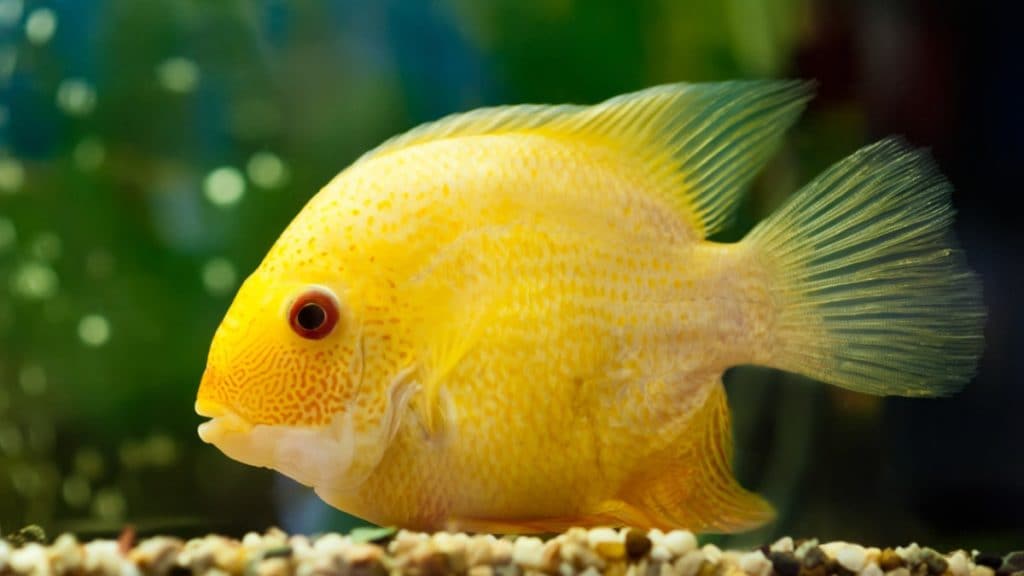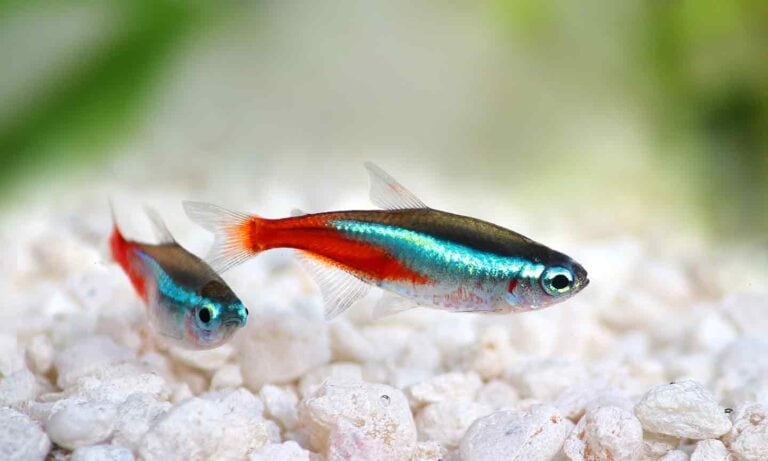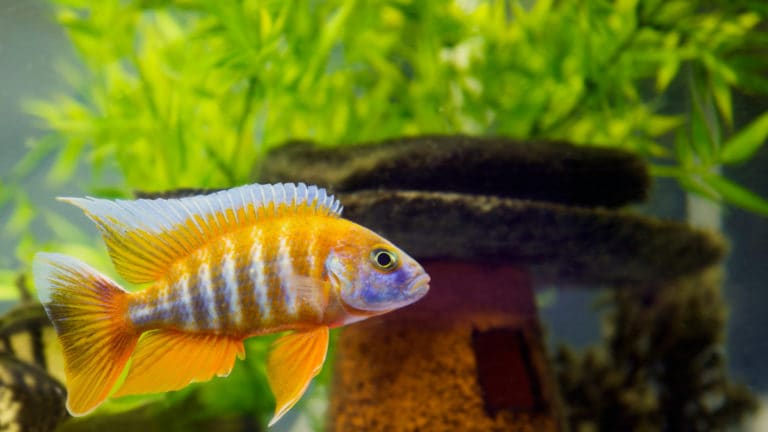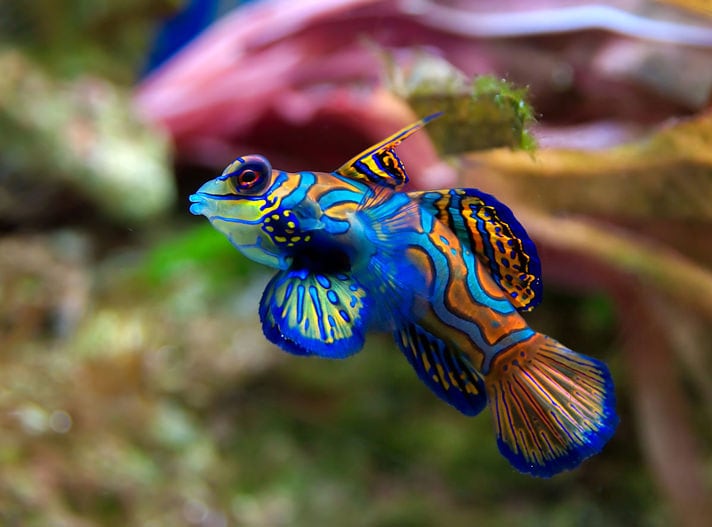Cichlids in general have a well-deserved reputation for being nasty, and beating up on their tankmates. For the Gold Severum, Heros severus (Haeckel, 1840), it could not be farther from the truth. Yes, they might be tempted to snack on a small neon tetra or the like, but Gold Severums are a peaceful fish, even though they are somewhat on the large side.
Origins
Gold severums are an aquarium industry creation, and trace their lineage back to the wild green severum. Found throughout the entire Amazon River Basin, including its tributaries and lakes, the severum has been around in the aquarium hobby for many years. My first copy of “The Innes Book” (Exotic Aquarium Fishes, by William T. Innes) dates back to 1950’s. The scientific name back then was Cichlasoma severum, but as with most fish the nomenclature / taxonomy of the fish has changed – but not as much as the names of many other fishes have changed.
The gold severum is what is known as a “leucistic” version of a normal animal. While it is often mistakenly referred to as an “albino,” the gold severum is definitely not an albino. Albino animals have reduced melanin – leucistic animals have a reduction in all pigmentation. Albino animals have pink eyes – leucistic animals have normal colored eyes. Beyond that brief perhaps confusing diversion, what is most important is simply that gold severums are spectacularly beautiful fish. While the normal wild form of the severum is basically a green/brown fish with speckles all over the body, and seven or eight wide black bands running vertically on the body of the fish. Gold severums are a creamy golden/yellow color, with red spots all over the body. Vertical lines do appear as fish age, and when they are in spawning attire.
Wild severum have a large area of distribution through the entire Amazon River Basin, but since gold severum are an aquarium bred strain of fish, they are not found in the wild. The gold color, as with albino fish, would essentially be a lethal gene, as those fish would stand out in the wild and be eaten before they even had a chance to grow much.
Keeping Severum in a Fish Aquarium
Gold severum, even though they can get to 6” – 8” are a very gentle and peaceful fish – and they are cichlids, which makes them stand out even more. I have kept and bred severum of both the green and gold variety, and the worst I have ever seen them do to another fish is to give them a nudge if their food was in danger. Gold severum do the familiar cichlid mating ritual of testing each other, but this is done with pushes and other challenges; they do not engage in the jaw-locking behavior of most other cichlids.
When it comes to aquarium conditions, since these become a fairly large fish they are best kept in as large an aquarium as possible. When you purchase small gold severums from your local fish store, they will probably be on the order of 2” in size. I strongly suggest that you keep them (and any juvenile cichlids for that matter) in a minimum of a 20 – 30 gallon tank to start. As they grow, which they will do quickly if fed enough of the proper fish food and given frequent partial water changes, you will want to move them up to a 55 gallon tank or larger. All Severum will do well in an aquarium with soft and acid water, but anything higher than a 7.2 pH should be avoided. The exception here is that if the severum you buy (either green or gold) have been bred in Florida, they will be used to higher pH and harder water. Gold severum do best on the high side of “tropical”, in the range of 78 – 82 degrees F.
Feeding gold severum is very easy, as they have been commercially raised and are used to regular dry prepared fish foods. They also appreciate some “treats” such as the occasional brine shrimp, blood worm or mysis shrimp. Their standard fare should consist of lots of vegetable matter. They will thrive on the dry foods that have a high vegetable content, the best in my opinion being spirulina algae wafers. Gold severum should also be provided with regular vegetables in the form of squash, Romaine lettuce or any of the other people foods that we feed our fish. To keep the golden yellow deep and vibrant in gold severum it is important to feed them prepared foods that are high in carotenoids – please do not fret, your local fish store will know what these are.
Breeding Gold Severum
These fish spawn in the general manner of all cichlids. They go through an elaborate pair selection and mating process, complete with some wrestling and otherwise testing the strength of each other. If you do want to breed gold severum it is best to start out with six to eight juvenile fish, and raise them together in an aquarium devoted just to them. In six to eight months from purchase pairs should begin forming, and as they mature one pair will become dominant in the tank. Part of this dominance involves pushing the other fish in the tank away from where the pair is going to spawn, so as soon as a pair has formed it is best to either remove the other fish, or to move the pair to a tank of their own. Gold severum are a substrate spawning fish, and they should be provided with some large flat stones to spawn on. Spawns are very large, with adult fish producing up to 1,000 eggs. In typical cichlid fashion, gold severum will protect and fan their eggs and the larvae, often moving them to different places in the tank. In about a week or so the fry should be free swimming, and as soon as that happens they will be looking for food. The best food for baby gold severums is newly hatched live baby brine shrimp. If that cannot be provided, frozen is a possible alternative; dry foods are a last resort.
Conclusion
Gold Severum are one of the most beautiful and hardy fish that we keep. They get fairly large, and do best in a tank of their own, and they will provide you with many years of pleasure, and if you want, babies.
Posted by: Chewy Editorial
Featured Image: iStock.com/expertm1973
Share:









